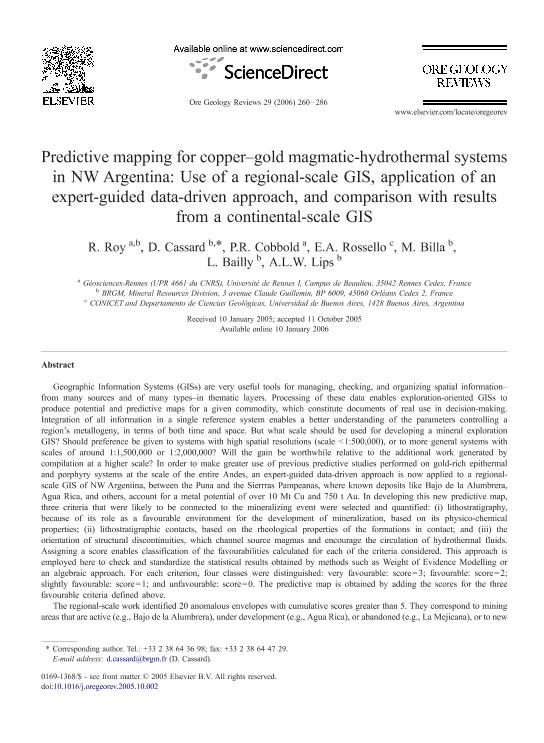Mostrar el registro sencillo del ítem
dc.contributor.author
Roy, R.
dc.contributor.author
Cassard, D.
dc.contributor.author
Cobbold, P. R.
dc.contributor.author
Rossello, Eduardo Antonio

dc.contributor.author
Billa, M.
dc.contributor.author
Bailly, L.
dc.contributor.author
Lips, A. L. W.
dc.date.available
2017-05-18T19:43:16Z
dc.date.issued
2006-11
dc.identifier.citation
Roy, R.; Cassard, D.; Cobbold, P. R.; Rossello, Eduardo Antonio; Billa, M.; et al.; Predictive mapping for copper–gold magmatic-hydrothermal systems in NW Argentina: Use of a regional-scale GIS, application of an expert-guided data-driven approach, and comparison with results from a continental-scale GIS; Elsevier Science; Ore Geology Reviews; 29; 3-4; 11-2006; 260-286
dc.identifier.issn
0169-1368
dc.identifier.uri
http://hdl.handle.net/11336/16669
dc.description.abstract
Geographic Information Systems (GISs) are very useful tools for managing, checking, and organizing spatial information– from many sources and of many types–in thematic layers. Processing of these data enables exploration-oriented GISs to produce potential and predictive maps for a given commodity, which constitute documents of real use in decision-making. Integration of all information in a single reference system enables a better understanding of the parameters controlling a region’s metallogeny, in terms of both time and space. But what scale should be used for developing a mineral exploration GIS? Should preference be given to systems with high spatial resolutions (scale b1:500,000), or to more general systems with scales of around 1:1,500,000 or 1:2,000,000? Will the gain be worthwhile relative to the additional work generated by compilation at a higher scale? In order to make greater use of previous predictive studies performed on gold-rich epithermal and porphyry systems at the scale of the entire Andes, an expert-guided data-driven approach is now applied to a regionalscale GIS of NW Argentina, between the Puna and the Sierrras Pampeanas, where known deposits like Bajo de la Alumbrera, Agua Rica, and others, account for a metal potential of over 10 Mt Cu and 750 t Au. In developing this new predictive map, three criteria that were likely to be connected to the mineralizing event were selected and quantified: (i) lithostratigraphy, because of its role as a favourable environment for the development of mineralization, based on its physico-chemical properties; (ii) lithostratigraphic contacts, based on the rheological properties of the formations in contact; and (iii) the orientation of structural discontinuities, which channel source magmas and encourage the circulation of hydrothermal fluids. Assigning a score enables classification of the favourabilities calculated for each of the criteria considered. This approach is employed here to check and standardize the statistical results obtained by methods such as Weight of Evidence Modelling or an algebraic approach. For each criterion, four classes were distinguished: very favourable: score = 3; favourable: score = 2; slightly favourable: score = 1; and unfavourable: score = 0. The predictive map is obtained by adding the scores for the three favourable criteria defined above. The regional-scale work identified 20 anomalous envelopes with cumulative scores greater than 5. They correspond to mining areas that are active (e.g., Bajo de la Alumbrera), under development (e.g., Agua Rica), or abandoned (e.g., La Mejicana), or to new areas (e.g., the Vicun˜a Pampa Volcanic Complex). Structural analysis of the region, integrating the orientation of the favourable envelopes, suggests that the mineralizing fluids were emplaced under extensional conditions, sub-parallel to the principal directions of shortening: (i) WNW–ESE, found along the southern edge of the Puna; and (ii) E–W, seen in the Sierra de Famatina. It appears that a regional-scale information system is a tool that is well suited to the definition of areas for mineral prospecting, and to the study and confirmation of metallotects usable for mineral exploration. Comparison with work conducted on the basis of a 1:2,000,000 geological compilation shows that the principal mining districts can indeed be found at continental scale. On the other hand, the lack of detail inherent at a scale of 1:2,000,000 may lead to inaccuracies, in particular fictitious favourabilities assigned to formations that are genetically unrelated to the mineralization, but that contain, for example, small Tertiary intrusive bodies that cannot be recorded at this scale. This comparison therefore shows that the use of a continental-scale GIS is effective, and well suited to the definition of prospective areas at a strategic level.
dc.format
application/pdf
dc.language.iso
eng
dc.publisher
Elsevier Science

dc.rights
info:eu-repo/semantics/openAccess
dc.rights.uri
https://creativecommons.org/licenses/by-nc-nd/2.5/ar/
dc.subject.classification
Geología

dc.subject.classification
Ciencias de la Tierra y relacionadas con el Medio Ambiente

dc.subject.classification
CIENCIAS NATURALES Y EXACTAS

dc.title
Predictive mapping for copper–gold magmatic-hydrothermal systems in NW Argentina: Use of a regional-scale GIS, application of an expert-guided data-driven approach, and comparison with results from a continental-scale GIS
dc.type
info:eu-repo/semantics/article
dc.type
info:ar-repo/semantics/artículo
dc.type
info:eu-repo/semantics/publishedVersion
dc.date.updated
2017-05-17T17:47:05Z
dc.journal.volume
29
dc.journal.number
3-4
dc.journal.pagination
260-286
dc.journal.pais
Países Bajos

dc.journal.ciudad
Amsterdam
dc.description.fil
Fil: Roy, R.. Universite de Rennes I; Francia. Bureau de Recherches Géologiques et Minières; Francia
dc.description.fil
Fil: Cassard, D.. Bureau de Recherches Géologiques et Minières; Francia
dc.description.fil
Fil: Cobbold, P. R.. Universite de Rennes I; Francia
dc.description.fil
Fil: Rossello, Eduardo Antonio. Universidad de Buenos Aires. Facultad de Ciencias Exactas y Naturales. Departamento de Ciencias Geológicas; Argentina. Consejo Nacional de Investigaciones Científicas y Técnicas; Argentina
dc.description.fil
Fil: Billa, M.. Bureau de Recherches Géologiques et Minières; Francia
dc.description.fil
Fil: Bailly, L.. Bureau de Recherches Géologiques et Minières; Finlandia
dc.description.fil
Fil: Lips, A. L. W.. Bureau de Recherches Géologiques et Minières; Francia
dc.journal.title
Ore Geology Reviews

dc.relation.alternativeid
info:eu-repo/semantics/altIdentifier/doi/http://dx.doi.org/10.1016/j.oregeorev.2005.10.002
dc.relation.alternativeid
info:eu-repo/semantics/altIdentifier/url/http://www.sciencedirect.com/science/article/pii/S0169136805001058
Archivos asociados
